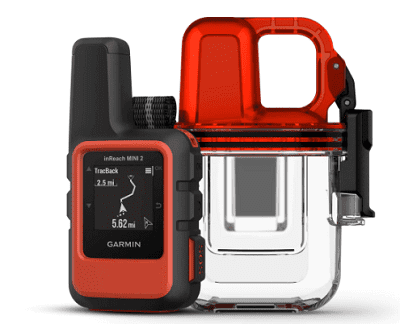Home › All about Scuba › Equipment › Accessories › Personal Locator Beacons
Personal Locator Beacons in Scuba Diving
There are several reasons why some scuba divers carry a PLB underwater. But, the most important is the ability to send out an emergency distress signal.
This guide explains how a Personal Locator Beacon works in water, which PLBs are best (e.g. Garmin, Nautilus) and the key differences between PLB and EPIRB.
What is the Personal Locator Beacon (PLB)?
Diver safety is not always a priority for all scuba accessories and diving gadgets available on the market.
But, being able to trigger a signal for help is the first concern for divers who carry a Personal Locator Beacon.
In fairness, these small safety devices are carried more often by people seeking adventure in remote locations (e.g. backpackers, hikers).
Even so, PLBs are becoming more popular with scuba divers looking for enhanced assurance during an emergency situation.
The small electronic device can transmit a distress signal to satellites in orbit, using the 'Search and Rescue Satellite Aided Tracking' (SARSAT) network. In fact, a constellation of satellites orbiting the Earth (about 66) carry radio receivers.
Following that, an appropriate authority that receives your distress call (e.g. coastguard, rescue helicopters) would be able to pinpoint your exact position in the water and initiate an emergency response.
Pro Tip: Emergency Position Indicating Radio Beacons (EPIRBs) are more commonly used for marine safety, such as on boats and ocean-going ships.
Vital Information for Emergency Responders
Imagine this scenario, you already completed the PADI DSMB Specialty and you use it in a strong current. You are hoping the crew on the support vessel will see your inflatable signal tube and notice how fast you are drifting away from the intended rendezvous point.
To make matters worse, you and your buddy drift out of sight and blowing on your surface signaling devices (e.g. whistle and air horn) don't get the attention you need.
Well, the modern method of contacting help is now available - the Personal Locator Beacon (PLB) for scuba divers.
Here's the thing:
Ask yourself this question, is scuba diving insurance necessary, and even if it isn't, would you dive without it? The PLB is a scuba accessory that could save your life - much like the coverage from diving insurance!
Almost all Personal Locator Beacons have an antenna, and you need to have it extended for it to work. In addition, some PLB beacons actually include a strobe light for enhanced visual location.
In an emergency situation, the device sends data via an emergency beacon to a local use terminal. From there, a message is relayed to the mission control center, and the information they receive usually includes:
 An emergency contact person (who would be able to confirm details with the rescue coordination center).
An emergency contact person (who would be able to confirm details with the rescue coordination center).- The name of the person who registered as being the owner of the Personal Locator Beacon.
Different Types of 406 MHz Distress Beacons
There are three kinds of 406 emergency beacons used to transmit distress signals:
- Emergency Position Indicating Radio Beacon (EPIRB is meant for maritime use)
- Emergency Locator Transmitters (ELTs are for use in aviation)
- Personal Locator Beacon (PLBs are handheld personal, portable units meant for remote-environment, scuba diving, or wilderness use)
It is best for scuba divers to carry the GPS-enabled PLB because they have a higher accuracy rating for sending an exact location to Search and Rescue (SAR).
Divers should also carry one that is waterproof so it will work underwater. Plus, choosing a PLB with a global range and a long battery life (average is 5 years) means it will remain functional when you need it most.
What is the Best PLB for Scuba Diving?
Nautilus LifeLine Marine Rescue GPS
The Nautilus LifeLine PLB is ideal for scuba divers, snorkelers, freedivers, and sailors. It is free to use, and it works anywhere in the world.
Plus, the Position Advisory function lets boat traffic know exactly where you are - without triggering an emergency response.
Navimate™ GPS for Scuba Divers
Knowing the exact latitude and longitude of a location underwater is one of the main features. But, it also includes detailed maps of the underwater terrain (if available) and it can guide you back to the dive boat.
Another benefit of the Navimate is being able to mark an interesting location. Thus, divers will be able to return to the exact spot on future dives. It can also show the position of diving buddies, share air pressure information, and send out an SOS.
Garmin inReach Mini 2
Even though the inReach Mini 2 is not an actual PLB, it is good for lost diver situations. Instead of using satellites, it connects to the private Iridium® satellite network.
After activating the SOS function, the device makes contact with International Emergency Response Coordination Center (IERCC) at Garmin.
Following that, they forward the relevant information to the appropriate local authorities - along with your personal emergency contacts.
Important: Activating a Personal Locator Beacon in a situation where no emergency exists is a criminal offence in some countries. Hence, misusing a PLB can result in a fine and penalties, including imprisonment.
Related Information and Help Guides
- What is PAN PAN Repeated Three Times in Radio Call?
- Dive Rescue Equipment for Scuba Emergencies
- Missing Diver Procedure Explained for Beginners
- The Most Common Cause of Diver Emergencies
- What's the Best Tow for Going Fast Over a Short Distance?
Pro Tip: The short video [11:45 seconds] presented by Simply Scuba explains some of the pros and cons of Scuba Rescue GPS devices.